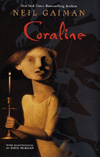Coraline

Gaiman, Neil. Coraline. New York: HarperCollins Publishers, 2002. ISBN 0-380-97778-8, hc, 162 pp., $15.99.

(This review originally appeared in Mythprint 39:8 (#245) August 2002.)
Reviewed by Emily Lauer
Coraline is the story of a young girl (“the same age as Alice,” says Gaiman) who discovers that a door in her apartment which should lead nowhere in fact leads Somewhere. Coraline goes though it to discover a world just enough unlike her own to be disturbing. She meets her Other Mother and Other Father and the Other residents of her building. The denizens of this Other place are at first vaguely unsettling but quickly (the book is only 162 pages; of course it’s “quickly”) become downright menacing.
In her own world, Coraline is an explorer, and she eventually must use her exploring skills in this Other place to free her parents and some incidental prisoners from the archvillain, the Other Mother. She is aided in this endeavor by a talking cat who can inhabit both worlds, and hindered and threatened by a consortium of talking, singing rats, brilliantly drawn by Dave McKean.
I’ll point out that this is one instance where living in the USA has its advantages. The U.S. edition of Coraline is graced with the magnificent and layered artwork of Dave McKean (who did covers for Gaiman’s Sandman series as well as the illustrations for The Day I Swapped My Dad for Two Goldfish) while the British edition has no illustrations at all.
Neil Gaiman’s prose, like Dave McKean’s illustrations, is deceptively simple. Coraline is, after all, a children’s book. At first reading, Coraline seems a book destined for rereading, so it is lucky the illustrations are multifaced enough to be interesting at each reading. A parent reading aloud, a child being read to, and adults or children reading to themselves can all enjoy the prose and illustrations on a variety of levels.
The first time around, I got through about half of Coraline before realizing that I just wasn’t going to be happy reading it until I went back and underlined all my favorite lines thus far. There’s about two underlinings to a page in my copy, most of which are pithy one-liners about relations between children and adults, or distinct references to other texts that I wanted to note, or examples of Alice-like good manners on Coraline’s part. Some of my underlinings, however, denote what pundits might refer to as a moral. Coraline says, “when you’re scared but you still do it anyway, that’s brave.” And that is acceptable because, after all, Coraline is billed as a children’s book and can get away with telling us about Bravery, or Family, or True Friendship in a way that we would not stand for in a book marketed as adult literature. Which leads to an interesting distinction between adult and child readings of Coraline.
Gaiman has mentioned repeatedly that children read Coraline as an adventure and adults read it as horror. I suppose I am in the ultimate grey zone, having read it as Literature with a capital L. Coraline fits firmly into the established canon of children’s literary fantasy; whether that precludes a classification of horror or adventure is beyond my ken.
Several things in this book are reminiscent of other works: a female protagonist is pitted against an older female villain. In a reversal of roles, a child must save her parents. A girl climbs through a household fixture into a world that almost mirrors her own. I am not saying this is a reason not to read Coraline, but rather a reason to also read Alice in Wonderland. And fairy tales in their original form. And most books by E. Nesbit.
If you are a parent, why not take the occasion of Coraline‘s obvious homages to other works to read those books to your children as well? Or, if you are an adult who never got around to reading Alice, why not read it now? Coraline is a terrific example of intertextuality adding to the levels of enjoyment of a book: It is perfectly possible to wholeheartedly enjoy Coraline without having read anything else, ever. And once you’ve done that, why not read everything else that can add to your enjoyment of it?
[Editor's note: Neil Gaiman launched Coraline, his first young adult novel, by giving a complete reading of the book on July 2nd, 2002, in Berkeley, California. I was able to attend this evening event, which lasted 4 hours (including a half-hour break for cookies and lemonade) and was an utterly delightful introduction to the book. I hope Gaiman has started a trend here: I think ALL authors should read their new books to us!!]
